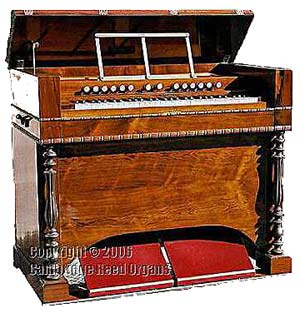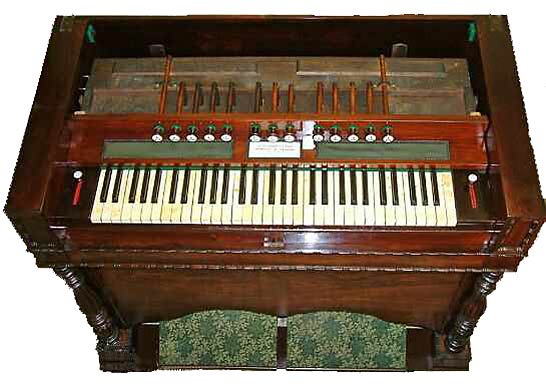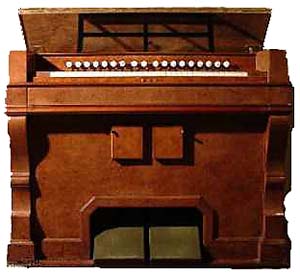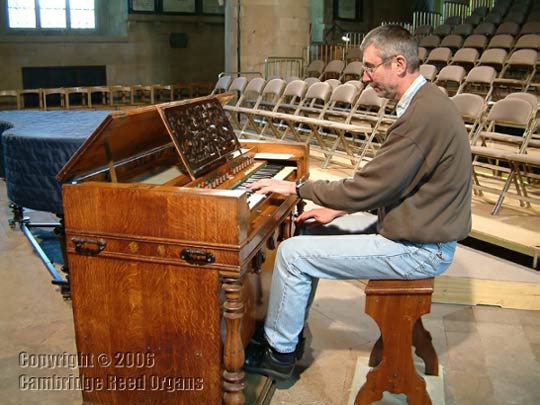Humble Relations
David Bridgeman-Sutton shifts his attention to France in his quest to find out why the harmonium is regaining popularity.
Keyboard instruments using free reeds without resonators (pipes) were developed in the eighteenth century; a Copenhagen physician and a French instrument maker, working independently, are credited with developing the first tolerable models.
Later, various Paris instrument makers worked to improve these and numerous patents were granted, from about 1840 onward, in the names of Alexandre, Dublain, Mustel and others. The harmonium varies considerably from the American reed-organ.
Later, various Paris instrument makers worked to improve these and numerous patents were granted, from about 1840 onward, in the names of Alexandre, Dublain, Mustel and others. The harmonium varies considerably from the American reed-organ.
|
Picture 1 shows an example by Alexandre. If this is compared with any of the American instruments the much simpler style of case is immediately evident. Another immediate clue is that the manual compass of 5 octaves runs from C to c - two octaves below and three octaves above middle c. (American organs have a compass from FFF.) The name of the maker usually confirms the nationality of an instrument, but not invariably so. Dealers on a large scale would import harmoniums - sometimes in their component parts - and inscribe these with their own names. One firm that used this early private-branding arrangement was Wheatstone and Co of London. Labels on the stop heads are usually (rather beautiful) ceramics, with lettering in block Roman: American organs employ Gothic script on celluloid labels.
|
|
stops on the right
As in the American organ, the keyboard is divided: the bass stops run from lowest C to the e above middle c; the treble registers sound from f above middle c to the top. In picture 2, showing an instrument from above, the usual arrangement is seen - bass stops, left; general controls, centre; treble stops, right. Nomenclature varies somewhat between makers, and stop names usually give little indication of the sounds each will make. Players are greatly helped by the system of stop-numbering sets of reeds. |
The chief 8' register, which is often labelled "Cor Anglais" in bass and "Flute" in treble, is numbered "1". This figure, like the others, appears in a circle at the top of the labels. The 4' stop ("Clairon" bass, "Fifre" treble) is numbered "3", the 16' register (Bourdon/Clarinette) "2"; while "4" is another 8 foot register of different tone (often Bassoon/Hautbois). In larger harmoniums, additional stops may be found, with their own numbering systems. Anyone called to accompany singing on such an instrument for the first time should remember to draw stops in pairs: alarming results are then avoided.
|
The extreme left and right hand stops, labelled "Forte" are numbered "0". In picture 2, it will be seen that the shanks of these stops, which are longer than the rest, are attached to long flaps or shades. The sliding back of these increases the volume of sound in bass and treble respectively. In some models, this action is performed by knee-swells (pic 3)
Many players regard the harmonium as the most expressive of keyboard wind-instruments. |
It owes this to a device brought into action by a stop knob labelled "Expression", marked with a letter "E" in block capitals above the word: this is placed centrally with other general controls. Usually - ie when this stop is not drawn - the wind passes from the bellows into a spring-loaded reservoir. This keeps pressure more-or-less steady; if pumping becomes over-energetic, surplus air is allowed to escape through a valve. The Expression stop isolates the reservoir, causing wind to pass directly from the bellows to the wind-chest. Volume can then be varied through a fairly wide range by varying the force applied to the pedals.
Practice is needed to ensure a constant wind supply when the Expression stop is in use: the results from this, in improved performance in such areas as phrasing, make it time well spent. Inexperienced people, playing in public, should avoid the device as they would the plague; the resultant succession of hoots and dying wails is guaranteed to produce astounded silence from the most enthusiastic singers, congregations or audiences. The need for fine control when the stop is in use, makes a good sitting posture even more important than it is with the American reed-organ. Picture 4 shows a player using the high, sloped seat that many find best adapted to the purpose.
Practice is needed to ensure a constant wind supply when the Expression stop is in use: the results from this, in improved performance in such areas as phrasing, make it time well spent. Inexperienced people, playing in public, should avoid the device as they would the plague; the resultant succession of hoots and dying wails is guaranteed to produce astounded silence from the most enthusiastic singers, congregations or audiences. The need for fine control when the stop is in use, makes a good sitting posture even more important than it is with the American reed-organ. Picture 4 shows a player using the high, sloped seat that many find best adapted to the purpose.
|
Free reeds tend to be fairly slow in speech, which poses problems when playing rapid or strictly rhythmic passages. An feature to overcome this is found in more-expensive harmoniums. The stop "Percussion" (marked "P") causes a piano-like action to strike the reeds of the number 1 row) as keys are depressed. This greatly speeds up response: many players keep this stop drawn almost all the time.
A number of composers have seen the potential of the harmonium and have written for it, sometimes in combination with a piano. These range from Vierne and Franck to Karg-Elert and Percy Grainger, while Rossini gave it an important part in his Messe Solonelle. In more recent years, it has found a place in popular music and interest in it as a home instrument seems to be growing. |
Anne Page is an Australian organist, now resident in Cambridge, England, who specialises in harmonium playing. Her CDs show what can be done with the instrument by those who work to develop the necessary technique. If you can, listen to one of these recordings here and revise your ideas about this "humble relation".
David Bridgeman-Sutton,
October, 2007
October, 2007
Picture credits:
Thanks to Cambridge Reed organs at www.harmonium.co.uk/ especially to Tim Clayton and Bruce Dracott; also thanks to Althea Bridgeman-Sutton
Thanks to Cambridge Reed organs at www.harmonium.co.uk/ especially to Tim Clayton and Bruce Dracott; also thanks to Althea Bridgeman-Sutton






